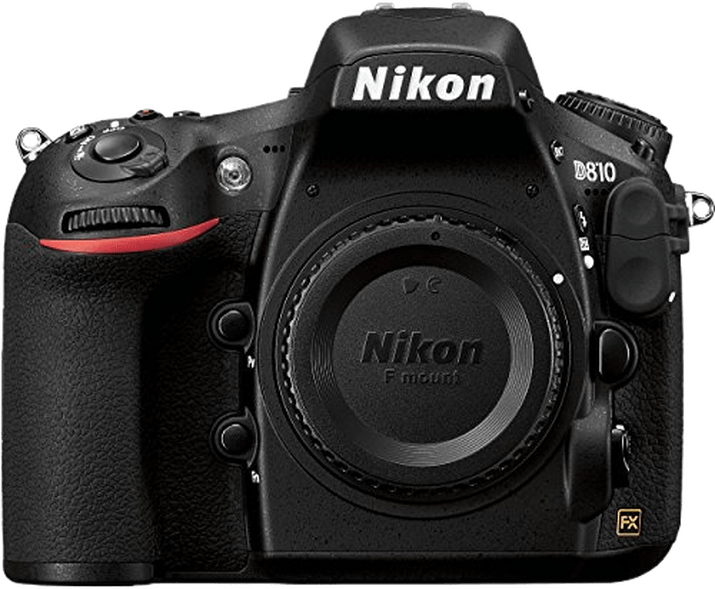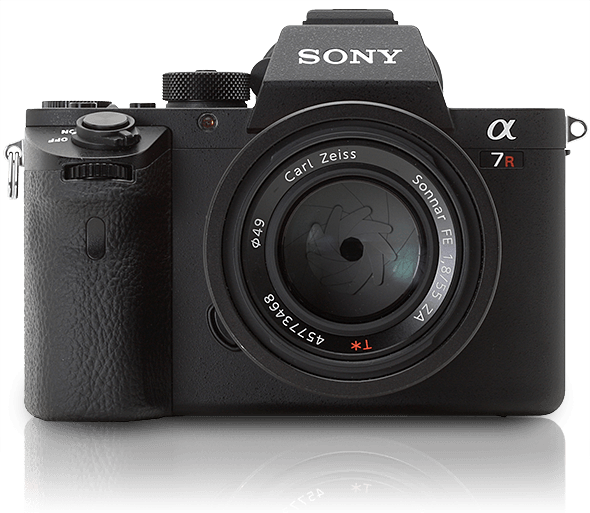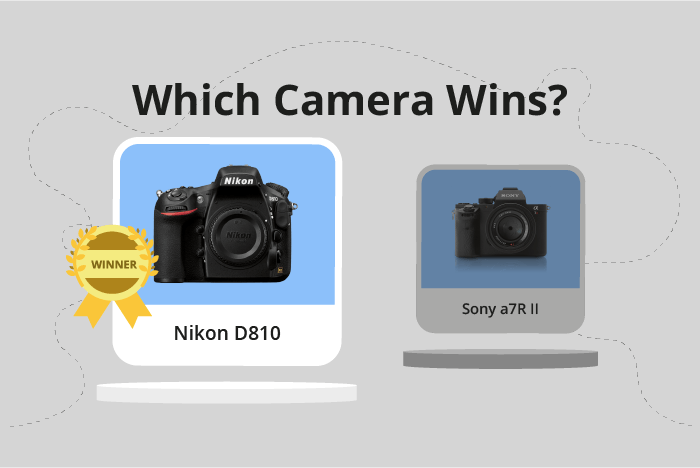Nikon D810 vs Sony a7R II Comparison
Nikon D810

Sony a7R II

The Nikon D810 edges out the Sony a7R II with a score of 72/100 compared to 70/100. Both cameras were released in 2014 and 2015, with launch prices of $3300 and $3198, respectively. They share common specifications, such as being high-quality DSLRs and mirrorless cameras.
The Nikon D810 stands out with its larger size (146 x 123 x 82mm) and heavier weight (980g / 2.16lbs), offering a more robust build. On the other hand, the Sony a7R II is more compact and lightweight (127 x 96 x 60mm, 625g / 1.38lbs), making it more portable and easier to handle.
Taking these factors into account, the Nikon D810’s higher score reflects its sturdier build, while the Sony a7R II offers portability and ease of use. Both cameras have their merits, and the choice ultimately depends on the photographer’s preferences and needs.
Nikon D810 vs Sony a7R II Overview and Optics
The Sony a7R II outperforms the Nikon D810 in optics, scoring 81/100 compared to the Nikon’s score of 76/100. Both cameras share several specifications, including a full-frame CMOS sensor, a shooting speed of 5 frames per second, and lens mounts specific to their respective brands (Nikon F FX for the D810 and Sony FE for the a7R II).
The Sony a7R II’s higher score is mainly due to its superior 42.4-megapixel count, compared to the Nikon D810’s 36.3 megapixels. This difference allows the Sony a7R II to capture more detail in images. Additionally, the Sony a7R II has a slightly better DXOMARK score for its sensor (98) than the Nikon D810 (97), indicating better overall image quality. The Sony a7R II also features image stabilization, which the Nikon D810 lacks. This feature helps reduce the chances of blurry images caused by camera shake.
On the other hand, the Nikon D810 benefits from the Expeed 4 processor, which is a powerful and reliable image processor. However, the Sony a7R II’s Bionz X processor is also highly competent, so this advantage is relatively minor.
In terms of optics, the Sony a7R II is the better camera due to its higher megapixel count, better DXOMARK score, and the presence of image stabilization. The Nikon D810 remains a strong competitor, but its lower score in optics makes it less appealing for photographers prioritizing image quality and detail. While both cameras have their merits, the Sony a7R II’s superior optics make it the preferred choice for photographers who value high-quality images.
Nikon D810 vs Sony a7R II Video Performance
The Nikon D810 outperforms the Sony a7R II in video capabilities with a score of 70 out of 100 compared to the Sony’s 56. Both cameras share some common video features, such as having Full HD (1920 x 1080) resolution and built-in time-lapse functionality. However, there are notable differences between the two models that contribute to the Nikon’s higher score.
The Nikon D810 boasts a higher maximum video frame rate of 60fps, compared to the Sony a7R II’s 30fps. This enables the D810 to capture smoother and more detailed footage, particularly in fast-paced or action-packed scenes. Additionally, the D810’s built-in time-lapse functionality allows for creative and dynamic video effects without the need for external accessories or software.
On the other hand, the Sony a7R II offers 4K video resolution (3840 x 2160), which is a significant step up from the Nikon D810’s Full HD. This higher resolution allows for more detailed and sharper video quality. However, the lack of built-in time-lapse functionality may be a drawback for some users who value this feature.
Taking these factors into account, the Nikon D810 is the superior choice for videographers who prioritize smooth, high frame rate footage and built-in time-lapse capabilities. The Sony a7R II, while offering higher resolution, falls short in other aspects of video performance and may be better suited for those who prioritize resolution over other features.
Nikon D810 vs Sony a7R II Features and Benefits
The Nikon D810 edges out the Sony a7R II with a feature score of 59/100 compared to 57/100. Both cameras have similarities, including screen resolution, lack of touchscreen, absence of GPS, presence of WIFI, and no Bluetooth. However, each camera also has its own advantages.
The Nikon D810 boasts a larger screen size of 3.2 inches, compared to the Sony a7R II’s 3-inch screen. This provides users with a better view of their images and easier navigation through menus. Additionally, the D810’s screen resolution is slightly higher at 1,229,000 dots, compared to the a7R II’s 1,228,800 dots. This difference may not be noticeable in everyday use, but it still gives the D810 a slight advantage in terms of image clarity.
On the other hand, the Sony a7R II has a flip screen, which the Nikon D810 lacks. This feature allows for more flexible shooting angles and easier self-portraits. However, this advantage is not enough to outweigh the benefits of the larger screen size and higher resolution offered by the D810.
In comparing the Nikon D810 and Sony a7R II, the D810 takes the lead with its larger screen size and slightly higher resolution. While the a7R II does offer the additional convenience of a flip screen, this advantage is not enough to surpass the benefits of the D810’s larger screen and higher resolution. Ultimately, the Nikon D810’s features make it the better choice between the two cameras.
Nikon D810 vs Sony a7R II Storage and Battery
The Nikon D810 outperforms the Sony a7R II in storage and battery with a score of 79/100, while the Sony a7R II scores only 16/100. Both cameras accept SD/SDHC/SDXC memory cards, but the Nikon D810 has two memory card slots and also supports Compact Flash and UDMA cards. The Sony a7R II has only one memory card slot and supports Memory Stick Duo/Pro Duo/Pro-HG Duo cards as well.
The Nikon D810’s battery life is significantly longer, providing 1200 shots per charge using the EN-EL15 battery, while the Sony a7R II offers just 290 shots with its NP-FW50 battery. Neither camera has USB charging capabilities.
Despite the lower score, the Sony a7R II’s support for Memory Stick cards may be advantageous to some users. However, the Nikon D810’s superior battery life and additional memory card slot make it a better choice in terms of storage and battery performance.
Alternatives to the Nikon D810 and Sony a7R II
Are you still undecided about which camera is right for you? Have a look at these popular comparisons that feature the Nikon D810 or the Sony a7R II:

